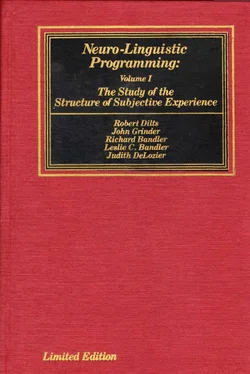Since its birth it has been a goal of behavioral science to achieve the same degree of elegance, reliability and precision which characterizes the physical sciences. From the vantage point offered by NLP, the inability of behavioral science to fully achieve this outcome becomes quite understandable. Historically, the physical sciences developed long before the behavioral ones. As many historians and philosophers of science have pointed out, the high regard and prestige which the physical sciences had attained seduced the founders of the behavioral sciences into adopting the methodology and form of the physical models. I select Newtonian physics as an initial reference point. The Newtonian model of physical systems was a representation of regular interactions which occur independently of the human observer. The most highly valued description or pattern or law in the Newtonian system was one where the maximum amount of context is deleted. In other words, heat, volume, density relationships of a gas in a confined space must hold independently of whether it's night or day, whether it's under water or in deep space, whether it's painted green or red, whether I want it to or not. . . [1] For the physicist, the question of whether the tree which falls in the forest, makes a sound even when there is no one to hear it, has the same force as how many angels can dance on the head of a pin.
Note, by the way, that while portions of models of physical systems may be effectively represented without appeal to NLP methodology, the representations themselves are subject to NLP modeling. Perhaps a simple example will be useful to the reader. All of us are conversant with a special mini–language called arithmetic. Arithmetic is a language which expresses facts about quantity. You, as the reader know which of the following expressions are well–formed, legitimate expressions in the language of arithmetic and which are not ( ).
(72 + 3) 3=
7- =14
= 4(7–3)
Further, you are able to evaluate the truth of well–formed legitimate expressions
20 + 4 =3 3–3 (true)
71–8=7+10 + ½ (false)
4√16 =2 (2 3) (true)
Now, consider the following expressions:
17 + 3√81 + 2 (5 2) +6 = 3 (6 2) -8
33 + 66+1 = 100
As the reader can easily determine (at least with a calculator) both of the expressions are well–formed, legitimate expressions in the language of arithmetic. Further, if the reader takes the time to compute them, it is easy to determine that they are both true—not only true, but each of them expresses the same fact, 100=100. Examine them carefully; and then consider the next expression:
8 + 27+1+64=100
Also states 100= 100 if we first change the sequence of this expression
1+8 + 27 + 64=100
then recode it into another form (chunking) leaving the meaning the same;
l 3+ 2 3+ 3 3+ 4 3=10 2
This expression is also well formed, true and expresses the same fact as the last three. Note that
1+2+3+4=10
that is, the sum of the first four whole integers (on the left hand of the expression) adds up to the integer on the right. A response is immediate — I become curious as to whether I could add the next whole integer and still preserve the truth of the statement — that is:
l 3+ 2 3+ 3 3+ 4 3+ 5 3= 15 2
And, in fact, the relationship holds. The point is that in terms of facts about quantities there is no difference in these last four expressions —that is, they all are well–formed true statements which express the same fact 100=100. Thus any difference in the response that I or any other person makes to them must be attributed to the sequence and form or representation of the expressions not the facts or content. But the response that we make is profoundly different. The form
l 3+ 2 3+ 3 3+ 4 3= 10 2
immediately invites me to a generalization — it suggests to me a pattern. The representation interacts in some yet unexplained way with my internal neurological organization so as to draw from me new possibilities or outcomes in algebraic code:
l 3+ 2 3+ 3 3+ … + n 3= (∑n) 2
In words: the sum of the cubes of the first n members of the set of whole integers equals the square of the sum of those numbers. Thus it seems highly likely that it is not only the observation of facts, nor only their measurement that engages human curiosity to extrapolate and explore. But the sequence and very form of data interacts with our neurology influencing it to subjectively make form of the same facts the basis of new meanings, while others lead us down old paths.
For example, one of the characteristics of a highly valued physical law in the Newtonian model is that any reference to humans is to be excluded. [2] Even the format specified by journals etc. as appropriate for reporting scientific generalization demands this. The syntactic device of a passive construction is stated as the most highly valued —expressions such as: "the animals were sacrificed …" "the results were obtained …" where the writer has deleted the subject/actor/agent.
Herein lies the flaw which has handicapped the behavioral scientist in ways it only detained the physical scientist.
In writing an introduction to the first of the books Bandler and I published, The Structure of Magic, vol. 1, Gregory Bateson states,
"Above all, they (behavioral scientists generally and psychiatrists specifically — J.G.) borrowed the concepts of physics and mechanics — energy, tension and the like — to create a scientism."
In Newtonian physical, mechanical systems, it is very useful to arrive at patterns which are independent of human influence. Technology is the application of those principles by humans to secure specific outcomes at the physical level. In arriving at patterns in human communication systems, it is wholly inappropriate to attempt to exclude reference to human influence since this is an essential portion of the domain of the field of study
In fact, among behavioral scientists there has been a growing uneasiness with the requirement to exclude from description the influence of the human agent (e.g. R Rosenthal experimenter effect).
Note that even in the physical sciences in more recent years the Newtonian theory of physical systems has been dislodged by a framework, whose origin is attributed primarily to Albert Einstein — a relativistic model. One of the significant differences between the Newtonian model and its successor is that the more recent model requires the inclusion of the perceptual point of the observer. As is implied in its name, the relativistic model demands an explicit representation of the perceptual position of the observer in describing certain space/time interaction.
The inclusion of the perceiver in descriptions of physical interactions represents a major increase in the descriptive power of the model. Take, for example, the Heisenberg Uncertainty Principle. Crudely put, the principle states that either the position or the state (kinetic energy) of the particle may be determined with precision but not both. The perceiver, in measuring the precise location of a particle, will disturb the state of that particle and vice versa— thus the value of both variables, location and state, can never be measured with precision.
There are three characteristics of effective patterning in NLP which sharply distinguish it from behavioral science as it is commonly practiced today. First, for a pattern or generalization regarding human communication to be acceptable or well–formed in NLP, it must include in the description the human agents who are initiating and responding to the pattern being described, their actions, their possible responses. Secondly, the description of the pattern must be represented in sensory grounded terms which are available to the user. This user–oriented constraint on NLP ensures usefulness. We have been continually struck by the tremendous gap between theory and practice in the behavioral sciences — this requirement closes that gap. Notice that since patterns must be represented in sensory grounded terms, available through practice to the user, a pattern will typically have multiple representation — each tailored for the differing sensory capabilities of individual users. I point out in passing that this requirement immediately excludes statistical statements about patterning as being well–formed in NLP as statistical statements are not user oriented. At best they indicate what the user might experience over a number of contexts but do not offer information about any specific situation. Insurance companies can predict costs, but salesmen will not know if this individual will trust, or dislike him or the inverse in advance, or initially face to face selling will succeed.
Читать дальше











